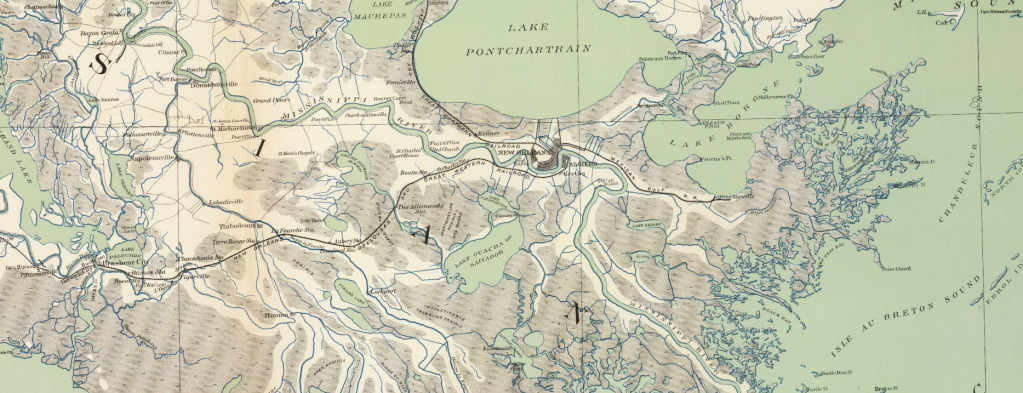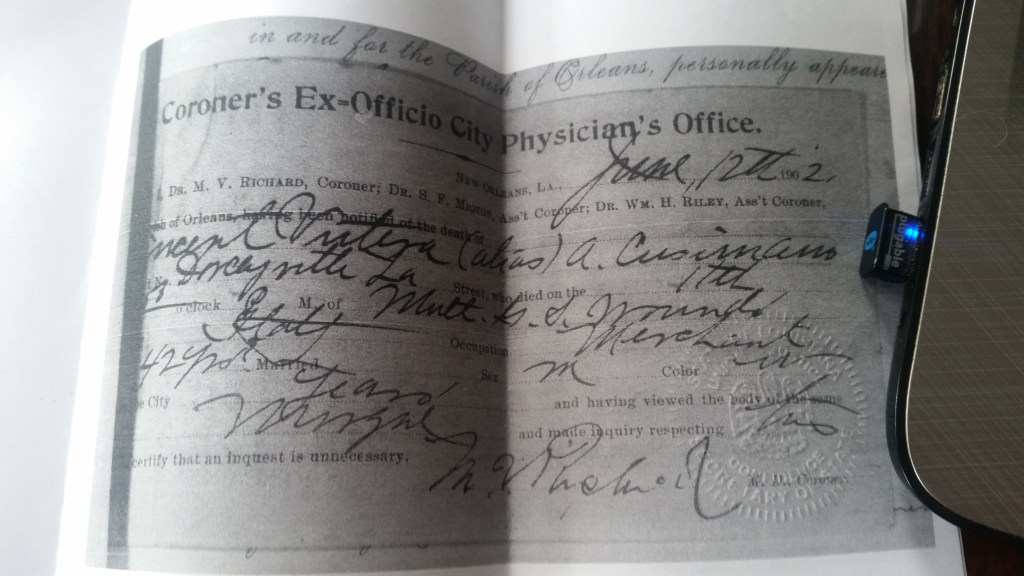News of the shootout at the Poydras street boardinghouse described one of the victims as weighing “fully 800 pounds.”
One of the first men killed in the Macaroni Wars was Vincenzo Vutera, placed in the Luciano’s business to suppress the opposition during a raid led by Santo “Joseph” Calamia. Like Vutera, Calamia is described as a “big, fat man” who could nonetheless move quickly. Straining credulity, local reporting on his death claims Vutera’s weight was “fully 800 pounds” (Sicilians in battle to death, 1902).
Another standout quality Vutera possessed was being from Corleone, the hometown he shared with Calamia’s professed brother-in-law, Giuseppe Morello, and his actual brother-in-law, Antonino Saltaformaggio, whose body turned up in a canal near White Castle in 1903. Hundreds of people from Corleone emigrated to Louisiana for work, with most of them dispersing into the plantations along the Mississippi River. Several families from Corleone lived in Donaldsonville, at the confluence of the Mississippi and the Bayou Lafourche.

In 1902, after a particularly bad flood season, the bayou was dammed, and a series of locks were discussed but never built. With access from the river blocked, 130 miles of navigable stream through coastal wetlands became accessible only from the Gulf of Mexico. The temporary dam permanently harmed the economy and health of Bayou Lafourche, Donaldsonville, and the surrounding area. The Mississippi no longer supplied fresh water to the bayou, devastating the ecosystem. The city of Donaldsonville, once the capital of Louisiana, entered a period of decline from which it did not rally until automobile traffic replaced riverboats as the primary form of transportation.
For the owners of a macaroni factory in Donaldsonville, the new dam was bad news. Easy access to half a dozen towns they might have provisioned along the bayou was suddenly cut off. Antonino Luciano had $4,000 tied up in the factory: about $129,000 in 2022 dollars. His partner was the duplicitous Paolo Di Christina, a mafioso in league with Francesco Genova.
Genova had sworn to destroy Luciano, and Di Christina was part of his plan. Step 1: Place men loyal to the Mafia boss in the business to be overtaken. Step 2: Make the business a source of debt and woe for the rightful owner. Step 3: Sap the owner’s funds, credit, and good name, until he has no choice but to abandon the property to his antagonistic partners. The Mafia has attacked business owners this way for most of its existence.
The showdown on Poydras Street in New Orleans was an escalation of a fight that began in the Donaldsonville macaroni factory. In the story that unfolded in the newspapers, and echoes in more contemporary tellings, Vincenzo Vutera is sometimes painted as an ally of the Luciano family, brought down from Donaldsonville to aid them in defense against Genova’s men, and at other times described as a plant, one of several men Genova either installed or turned to his purposes.

Vincenzo Vutera was born in Corleone in April 1872, and emigrated as a young man with his mother and his first cousin, also named Vincenzo Vutera, who was three years older. The older cousin returned to Corleone and married there in 1906, which is how I can be sure he was not the one shot to death in New Orleans in 1902.
Vutera married his first cousin, Giovannina “Jennie” Cusimano, in Donaldsonville in 1894. His wife’s godparents were her first cousin, once removed and her husband. They were also the parents of Los Angeles Mafia boss Jack Dragna. Dragna and Vutera (and Cusimano and Dragna) are second cousins.
Vutera’s same-name cousin has a maternal uncle, Mariano Colletto, who was a captain in the Fratuzzi, the Mafia of Corleone. The older Vutera may have run into some kind of legal trouble in Louisiana: in November 1901, one of the cousins ran an ad claiming not to be the V. Vutera who was decided against in a local court case. The younger Vincenzo Vutera was, at the time of his death, a grocer with a store in Dorseyville, eleven miles from Donaldsonville, which he ran under the name “A. Cusimano” because his own credit was so poor. The real A. Cusimano was Vincent’s brother-in-law and first cousin, Antonino Cusimano, who named Vincent as his destination contact when he emigrated to White Castle—near Donaldsonville—in 1897.
In January 1902, a notice ran for a “Constable Sale.” At auction were the provisions and equipment from Vincenzo Vutera’s Dorseyville grocery, being sold to satisfy his obligation to “A. Luciano.” The same Antonino Luciano who Genova swore to destroy was one of Vincenzo Vutera’s creditors.
The same Antonino Luciano who Genova swore to destroy was one of Vincenzo Vutera’s creditors.
Given this history, it’s little wonder that Genova found a willing accomplice in Vutera. “The Lucianos thought it rather strange when Vincenzo Vutera, the big, fat storekeeper, who was running a general merchandise place in Dorseyville under the name of Cusimano, to deceive his old creditors, came to their place a few evenings back and asked for a bed,” The Times-Picayune reported. The Lucianos, who had turned their business into a fortress, welcomed him into their boardinghouse.
Vutera’s debt with Luciano and the auction to pay it were not reported in the days following his death in the shootout. Instead, there was confusion about whose side of the deadly conflict Vutera had fought on. Had he been placed there by Calamia? Or, as Tony Luciano told the police and reporters, did Vutera die in a vain attempt to defend his brother Salvatore Luciano, the target of the attack?
New Orleans police believed Tony’s statement was a ruse. Based on statements from other witnesses and evidence on the scene, members of Calamia’s party killed Salvatore Luciano, and then Tony, his brother, killed Vincenzo Vutera. Tony may have also shot Joseph Gerrachi, who died weeks later in the hospital, and Joseph Calamia, who took two bullets in his left hand. Both Vutera and Gerrachi are described in the newspapers as managers of Luciano’s macaroni factory. A Luciano cousin who was injured in the shootout claimed Vutera was a traitor who had brought Gerrachi with him from Donaldsonville.
That evening, with Tony Luciano in custody, police told him Vutera had fired Gerrachi from his position in the factory. This appeared to confirm for Luciano his realization that Vutera (and perhaps also Gerrachi) had betrayed him, because it elicited from Luciano the names of the men who had invaded along with Calamia. Gerrachi, who was described as a merchant from Donaldsonville, was one of them, as well as Bartolo Ferrara, and two men who evaded arrest, Vincent Scaffino and Joe Galderone. Di Christina was seen across the street, immediately after the attack. Genova, the most powerful mafioso involved, was not part of the raid, but it was for the restoration of his honor that Salvatore Luciano was killed. Salvatore, Tony’s “hot-headed” brother, shot at Genova and Di Christina a month earlier, and was warned to leave the country or forfeit his life.
Vincenzo Vutera was playing cards in the annex, to the rear of the store, with Louis and Tony Luciano when Calamia and his men arrived. Salvatore Luciano, sitting near the annex, was killed by multiple stab wounds and a gunshot wound to the head. Vutera was killed by three gunshot wounds that entered the right side of his body, lacerating his lungs and liver, and a knife wound to the head. It’s likely that Vincenzo shot Salvatore, who had already received mortal injuries, and then Tony killed Vincenzo. In his pockets were a knife that had shattered on the impact of another bullet aimed at his chest, and some letters signed from “A. Cusimano.” Based on the letters, the coroner correctly assumed this was Vutera’s alias and included it in his death certificate.

Luciano avoided indictment in the Poydras Street shootings. Calamia stood trial for Vutera’s murder but was acquitted for lack of evidence. Vincenzo Vutera was only thirty years old, though the coroner indicated he was much older. He left a wife and four children, the youngest just four months old. Jennie Cusimano remarried a few years later to Charlie Peranio, born Vincenzo Piranio in Corleone, with whom she had two more children.

Sources
Babin II, D. (2015, April 28). Bumped off on the bayou: the macaroni wars.
Bloody battle. (1902, June 12). The Times-Democrat (New Orleans, LA).
Constable sale. (1902, January 11). The Weekly Iberville South (Plaquemine, LA). P. 2.
Kendall, J. S. (1911, October 1). The Mafia in New Orleans. The Times-Picayune (New Orleans, LA). P. 33.
Kingman, W. A. (n.d.) The Axeman of New Orleans. Retrieved 29 January 2019 from Serialkillercalendar.com.
Krist, G. (2014). Empire of sin: A story of sex, jazz, murder, and the battle for modern New Orleans. Crown.
Luciano lured to a mafia murder. (1903, August 10). The Times-Picayune (New Orleans, LA). P. 1.
More murder in the feud of Sicilians. (1902, June 13). The Times-Picayune (New Orleans, LA). Pp. 1+.
Notice. (1901, November 20). The Times-Democrat (New Orleans, LA).
Sicilians in battle to death. (1902, June 12). The Times-Picayune (New Orleans, LA).
Read Part 3 in this series on The Macaroni Wars: Francesco Motisi, Alias Genova
